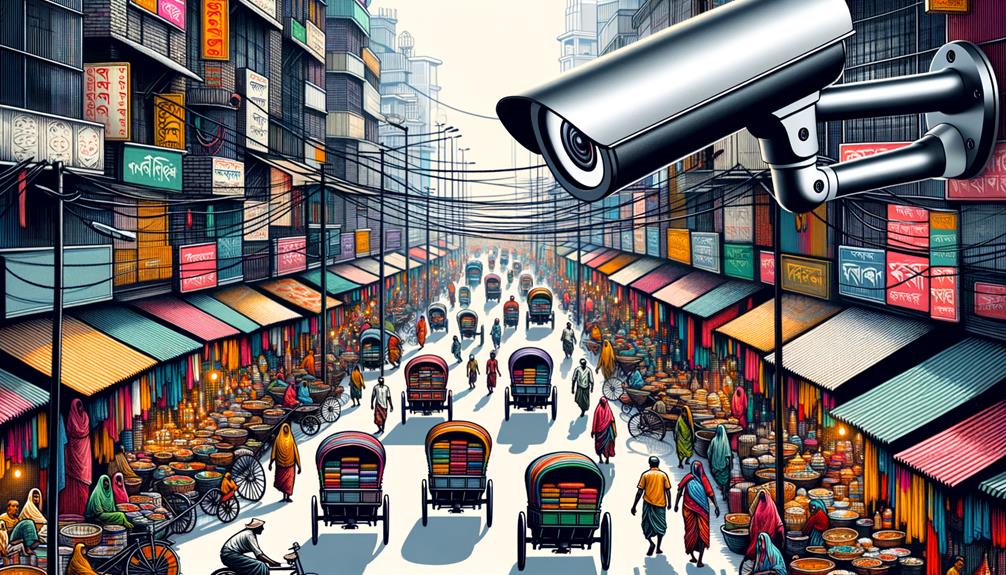Nestled in the north-western region of Bangladesh, Chapai Nawabganj District is a place that beckons with its enticing blend of rich history and awe-inspiring natural beauty. As a district that has witnessed the ebb and flow of empires, Chapai Nawabganj holds within its boundaries a tapestry of historical significance waiting to be unravelled. From ancient capitals to the formation of the district itself, this land has stories to tell. But it is not just the past that captures one's attention; the district's geography, with its majestic rivers and fertile soil, adds a touch of enchantment to the landscape. With its tropical climate and notable landmarks, Chapai Nawabganj District stands as a testament to the allure of both history and nature. So, come along on this journey, as we embark on an exploration of the wonders that await in Chapai Nawabganj District.
Historical Background
Chapai Nawabganj district has a rich historical background, shaped by the rise and fall of different empires and its association with ancient capitals of Bengal such as Gour and Pundrabardhana. The district holds immense historical significance due to its strategic location and architectural heritage. Gour, once the capital of the Bengal region, was known for its grand palaces, mosques, and tombs. The remnants of these architectural marvels still stand as a testament to the rich history of the area. Additionally, Pundrabardhana, another ancient capital, also contributed to the architectural heritage of Chapai Nawabganj. The district is a treasure trove of historical artifacts and structures that attract historians, archaeologists, and tourists alike. Its historical significance and architectural heritage make Chapai Nawabganj a fascinating destination for those interested in delving into the region's past.
Formation and Geography
The district of Chapai Nawabganj, located in the north-western part of Bangladesh, has a unique formation and geographical features that contribute to its distinct character and natural beauty. Exploring Chapai Nawabganj's Formation and Geography involves unearthing the past, unveiling the landscape, and uncovering historical roots and geographical wonders. This district has a rich historical background, with roots dating back to ancient capitals like Gour and Pundrabardhana. The area has witnessed the rise and fall of different empires, adding to its historical significance. In terms of geography, Chapai Nawabganj is surrounded by the Malda and Murshidabad districts of India, Naogaon District to the east, and Rajshahi District to the southeast. The district is blessed with rivers like the Ganges, Mahananda, and Pagla, which not only contribute to the district's economy but also provide irrigation facilities and support fishing activities. The climate in Chapai Nawabganj is tropical wet and dry, characterized by monsoons, high temperatures, humidity, and moderate rainfall. Overall, the formation and geography of Chapai Nawabganj make it a fascinating destination for those interested in unearthing its past, unveiling its landscape, and uncovering its historical roots and geographical wonders.
Landmarks and Places of Interest
With a rich historical background and natural wonders, Chapai Nawabganj District is home to several captivating landmarks and places of interest. One notable landmark is the Gono kabar, or mass grave, which holds great significance. It serves as a reminder of the sacrifices made during the Liberation War. Another landmark of historical importance is the Captain Jahangir bridge. This bridge has a fascinating history and was named after Birsrestha Captain Mohiuddin Jahangir, a war hero who sacrificed his life for the nation. The bridge stands as a symbol of bravery and resilience. Visitors can explore these landmarks and learn about the district's historical heritage. The presence of such landmarks adds to the charm and appeal of Chapai Nawabganj District.
Administration and Education
The administration of Chapai Nawabganj District plays a crucial role in managing and governing the various administrative divisions within the district, ensuring the smooth functioning of public services and governance. The district is divided into five Upazilas: Bholahat, Gomastapur, Nachole, Chapainawabganj Sadar, and Shibganj. These administrative divisions have their own unique characteristics and functions. The administration is responsible for maintaining law and order, providing essential services to the residents, and implementing government policies effectively. As for the education system in Chapai Nawabganj, the district is home to Exim Bank Agricultural University Bangladesh (EBAUB), which offers specialized education in agriculture and undergraduate degrees in Agricultural Economics, Business Administration, and Law. Other notable educational institutions in the district include Adina Fazlul Haque Govt. College and Nawabganj Govt. College, along with polytechnic institutes and medical colleges. The administration and education sector work hand in hand to ensure the overall development of the district and the well-being of its residents.
Demographics and Population
Chapai Nawabganj District boasts a diverse and vibrant population, reflecting the rich cultural heritage and historical significance of the region. According to the 2022 Census of Bangladesh, the district has a population of 1,835,527, with 25.5% residing in urban areas. The population density is 1,078 people per square kilometer, indicating a significant concentration of residents. The literacy rate in Chapai Nawabganj is 71.9%, highlighting the importance of education in the district. The majority of the population follows Islam, comprising 95.36%, while Hindus make up 4.04% of the population. This cultural diversity adds to the social fabric of Chapai Nawabganj, creating a harmonious coexistence and fostering a sense of unity among its residents. The district's population growth and cultural diversity contribute to its vibrant and dynamic atmosphere.
| Population | Urban Population | Population Density |
|---|---|---|
| 1,835,527 | 25.5% | 1,078/km² |
Media and Communication
Media and communication play a crucial role in connecting and informing the residents of Chapai Nawabganj District, facilitating the exchange of information and fostering a sense of community. In the district, media has a significant impact on promoting tourism and showcasing the natural beauty and historical landmarks of the area. The role of media in promoting tourism includes highlighting the cultural heritage, natural attractions, and tourist-friendly facilities available in the district. Through various platforms such as newspapers, television, and online media, information about local festivals, events, and tourist destinations can be disseminated to a wider audience, attracting visitors from both within and outside the district. Additionally, the impact of communication technology on the district has been transformative. The availability of mobile phones, internet access, and social media platforms has improved communication and connectivity, enabling residents to stay updated, share information, and engage in online discussions. This has not only strengthened community bonds but also facilitated the exchange of ideas, knowledge, and experiences, contributing to the overall development and progress of the district.
Cultural Heritage and Traditions
With its rich history and vibrant cultural traditions, Chapai Nawabganj District is a treasure trove of heritage that reflects the diverse cultural tapestry of Bangladesh. The district is known for its cultural festivals, which are celebrated with great enthusiasm and fervor. One such festival is the Boishakhi Mela, which marks the Bengali New Year. It is a colorful and joyous celebration that showcases traditional music, dance, and food. Another prominent festival is Eid-ul-Fitr, which marks the end of Ramadan. During this festival, the district comes alive with feasts, prayers, and gatherings. In addition to festivals, Chapai Nawabganj is famous for its traditional crafts. The district is known for its intricate weaving, pottery, and woodwork, which are passed down through generations. These crafts not only reflect the artistic talent of the local artisans but also contribute to the cultural heritage of the district.
Natural Beauty and Ecotourism
Nestled in the north-western part of Bangladesh, Chapai Nawabganj District captivates visitors with its breathtaking natural beauty and offers a haven for eco-tourism enthusiasts. The district boasts a remarkable biodiversity, making it a prime location for biodiversity conservation efforts. Adventure tourism thrives in Chapai Nawabganj, with numerous opportunities for outdoor activities and exploration.
- Explore the lush green forests: Chapai Nawabganj is home to expansive forests that provide a habitat for a diverse range of flora and fauna. Nature lovers can immerse themselves in the serene surroundings and witness the vibrant wildlife that calls these forests home.
- Discover the enchanting waterfalls: The district is peppered with stunning waterfalls, cascading down from the hills and creating a mesmerizing sight. Visitors can indulge in the thrill of hiking through the rugged terrain to reach these hidden gems and experience the sheer beauty of nature.
- Engage in river adventures: With the Ganges and Mahananda rivers flowing through the district, water-based activities are abundant. From boating and fishing to river rafting, adventure enthusiasts can satisfy their adrenaline cravings while immersing themselves in the natural splendor of Chapai Nawabganj.
Chapai Nawabganj District truly offers an escape into nature's wonders, making it an ideal destination for eco-tourism and adventure seekers.
Future Development and Opportunities
In light of its rich history, natural beauty, and abundant resources, Chapai Nawabganj District presents immense potential for future development and a wide range of opportunities for economic growth. With its strategic location near the border of India, the district has the advantage of being a hub for trade and business activities. The fertile agricultural land in the Diyar area provides a strong foundation for the growth of the agricultural sector, particularly in the cultivation of rice, wheat, melons, and mangoes. Additionally, the presence of rivers such as the Ganges, Mahananda, and Punarbhaba offers opportunities for irrigation, fishing, and water-based industries. The district's historical landmarks and cultural heritage also make it a potential tourist destination, attracting visitors and boosting the hospitality and tourism sectors. With proper planning and investment, Chapai Nawabganj District has the potential to become a thriving economic center in the region, contributing significantly to the overall economic growth of Bangladesh.
Frequently Asked Questions
What Are the Main Industries or Economic Activities in Chapai Nawabganj District?
The main industries and economic activities in Chapai Nawabganj district include agriculture, manufacturing, and trade. The fertile soil and favorable climate make agriculture a significant economic contributor, with rice, wheat, melons, and mangoes being major crops. The district also has manufacturing industries, such as textile mills and jute mills, which provide employment opportunities. Trade plays a vital role in the district's economy, with various markets and commercial centers facilitating business activities. These industries and economic activities contribute to the overall growth and development of Chapai Nawabganj district.
Are There Any Famous Festivals or Cultural Events Celebrated in Chapai Nawabganj?
Chapai Nawabganj district is known for its rich cultural heritage and vibrant festivals. The district celebrates several famous festivals and cultural events throughout the year. Some of the notable festivals include Eid-ul-Fitr, Eid-ul-Adha, Durga Puja, and Muharram. These festivals are celebrated with great enthusiasm and involve various cultural activities, including music, dance, and traditional performances. The local community actively participates in these events, showcasing the diverse cultural traditions and creating a lively atmosphere in Chapai Nawabganj.
What Are the Major Challenges or Issues Faced by the District in Terms of Infrastructure or Development?
Major challenges and issues faced by Chapai Nawabganj district in terms of infrastructure development include inadequate road networks, limited access to electricity and clean water, and insufficient healthcare facilities. The district also lacks proper sanitation systems and faces challenges in waste management. Moreover, there is a need for improved educational institutions and vocational training centers to enhance the skill development of the local population. Addressing these challenges is crucial for the overall development and progress of the district.
Is There Any Significant Archaeological Site or Ancient Ruins in Chapai Nawabganj?
Significant archaeological discoveries and the preservation of ancient ruins are integral to the rich history of Chapai Nawabganj District. The district boasts several notable archaeological sites, including the Choto Sona Mosque, a graceful monument from the Sultanate period. This mosque, built by Wali Muhammad, features unique gold-gilded domes. Additionally, the district is home to the Gono kabar (mass grave) and the Tohakhana Mosque, among other landmarks. The preservation of these ancient ruins showcases the district's commitment to honoring its historical heritage.
Are There Any Conservation Efforts or Initiatives in Place to Protect the Natural Beauty and Wildlife of Chapai Nawabganj?
Conservation efforts and initiatives are indeed in place to protect the natural beauty and wildlife of Chapai Nawabganj. The district is home to a diverse range of flora and fauna, including several endangered species. Local authorities, in collaboration with environmental organizations, have implemented measures to preserve and restore the natural habitats and ecosystems. These efforts include the establishment of protected areas, the implementation of sustainable practices in agriculture and land use, and the promotion of awareness and education programs to engage the local community in wildlife conservation.





